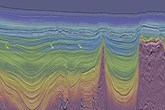Production monitoring with fibre optic strain, acoustics, and temperature
Published by Alfred Hamer,
Editorial Assistant
Oilfield Technology,
J. Andres Chavarria, Luna Innovations – OptaSense, USA, and Veronique Mahue, Silixa – a Luna company, UK, present an outline of available analysis tools to assess conditions in producing wells.
In-well fibre optic surveillance has grown rapidly with the use of distributed temperature, acoustic and strain sensors (DTS/DAS/DSS) that provide full wellbore characterisation. This characterisation can take place at any or all stages in the life cycle of the well. As different reservoirs and well completions deploy fibre within them, there has been a growing demand for specific sensing and analytic techniques that can provide operators with actionable assessments of production and well operations.
Production monitoring with FO sensing consists predominantly of profiling to assess zonal allocation, fluids and rates, and wellbore integrity measurements to assess potential operational issues of various in-well devices, annular spaces and their interaction with the reservoir.
This article focuses on current FO analysis tools that are used to assess production and that make use of the various FO interrogator units (IUs) that are available. Each of these instruments is tracking various physical properties of the fluids and well. Their individual use or their combination can provide different assessments for the given challenges of the reservoir.
Optasense and Silixa focus specifically on the use strain and acoustic measurements of production, that when coupled with temperature measurements, provide a detailed look at the reservoir dynamics and producing conditions.
Production monitoring via acoustics
Distributed acoustic sensing (DAS) has been deployed for production monitoring since the early 2010s. This has complemented DTS measurements that have been around for many more years. At the core of DAS sensors is FO technology that effectively measures a strain response in the well. This strain can be of a mechanical and/or thermal (i.e. expansion/contraction) nature and depending on the IU, these effects can be separated at the native sensing level or during real time processing. Depending on the IU, strain or strain-rate, measurements are provided and have different advantages depending on the final analysis tool. The main advantage of DAS sensors is that they provide the highest sensitivity due to their use of Rayleigh backscatter signals and the highest temporal and spatial sampling that are optimised to the configuration of the reservoir and well.
Other dedicated FO strain sensing (DSS) tools for production are available and can make use of the Brillouin spectra and more recently, the Rayleigh Frequency Shift (RFS), a subset of optical frequency domain reflectometry. In these methods the strain signals make use of weaker backscatter levels that require longer sensing times which makes them not as dynamic as conventional DAS strain techniques. Given the high sensitivity and fine resolution of DAS/DTS, this article focuses on the more dynamic Rayleigh OTDR techniques.
The use of DTS sensors becomes critical as more specific analysis of fluid compositions is required. This includes the situations when DAS or DSS measurements require compensation for temperature. Increasingly FO installations consist of a combination of DAS/DTS/DSS depending on the environment.
At higher frequencies, as fluids propagate from the reservoir into the wellbore, the vibrations imparted onto the fibre provide a high-resolution measurement of the dynamics and the interactions with the well architecture.
The earliest work on fibre optic sensing with DAS/DTS consisted of assessments of acoustics at higher frequency bands. These acoustics are created by the vibration of fluids as they propagate from the reservoir into the wellbore. Such analysis usually provides a real time assessment of zonal allocation and production zones and enables a real-time look at changing conditions in production levels. By using specific frequency band extracted data (FBE), insight can be gained into the different zones in the completion zone that are responding to the fluids being produced. This FBE analysis constitutes a rapid assessment of zonal allocation within the well.
To access the full version of this article and get a free trial subscription to Oilfield Technology, sign up here!
Read the article online at: https://www.oilfieldtechnology.com/special-reports/05032025/production-monitoring-with-fibre-optic-strain-acoustics-and-temperature/
You might also like
Viridien completes reimaging of BM-S-2 multi-client survey in Brazil’s southern Santos Basin
Viridien successfully completes BM-S-2 seismic reimaging project in the southern Santos Basin.

